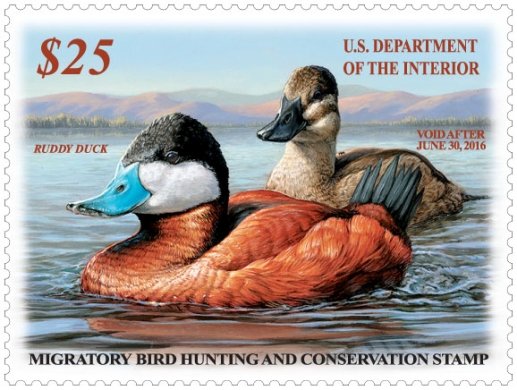
In 2015 a Federal Duck Stamp Task Force was convened under the auspices of the Association of Fish & Wildlife Agencies (AFWA) consisting of seventeen individuals. The purpose of the task force: “Under the leadership of the Waterfowl Working Group, the Federal Duck Stamp Task Group will develop a position statement, for consideration at the Association’s 2015 Annual Meeting, on policy issues pertaining to the recent price increase of the Federal Duck Stamp and the marketing and use of the Duck Stamp to increase hunting, public access, and conservation activities on National Wildlife Refuges.”
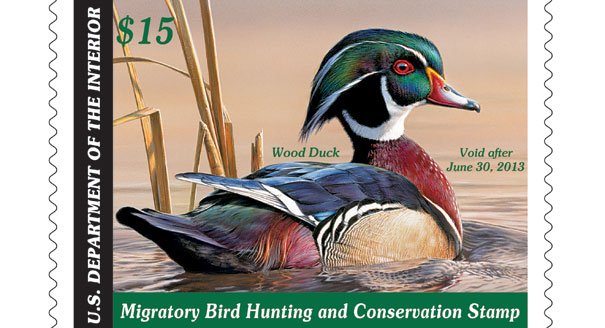
The Task Group issued its final report on September 15, 2015. There were five issues and recommendations of the group:
Issue 1: The conservation benefits of the Duck Stamp are poorly understood among the wildlife viewing community and the public, as well as among much of the hunting community
a) Recommendation: Develop and support implementation of a communications strategy that targets groups identified in the North American Waterfowl Management Plan (NAWMP) National Stakeholder workshops and survey.
b) Recommendation: Work with all groups to identify synergistic opportunities for promoting broad conservation benefits of the Duck Stamp.
Issue 2: Revenue from sales of Duck Stamp has declined and is insufficient to meet conservation goals.
a) Recommendation: Develop and support implementation of a marketing plan with specific sales and revenue goals for waterfowl hunters, other hunters, non-hunters and wildlife viewers, etc.
1) Action: U.S. Fish & Wildlife Service (FWS) should work with NAWMP/bird conservation community to identify and target specific messages and product(s) to the various market segments and identify the most appropriate and effective methods for sales and distribution. The NAWMP National Stakeholder Survey should help inform this effort.
2) Action: Identify aspirational sales and revenue goals for each state and market segment that are achievable based on past history, and the proposed marketing effort.
3) Action: Identify demographic information that is currently being collected by e-stamp states and additional information required for improving sales.
b) Recommendation: Determine a price point that optimizes sales and total revenue
1) Action: AFWA/FWS cooperate to model past, current and future sales data and the desirable price points for the stamp. This simulation could inform future efforts to increase the price of the stamp by the Consumer Price Index (CPI)
Issue 3: Purchasing a Duck Stamp should be efficient and easy.
a) Recommendation: Finalize plans and timeline for all states to sell electronic stamps through existing licensing systems.
b) Recommendation: Address issues regarding complications/shortcomings with existing e-stamp including 45 day expiration of the e-stamp.
1) Action: Change law to allow the e-stamp to suffice as the requirement to hunt waterfowl for the duration of the hunting season. The physical stamp could be sent to hunters after March 10th each year.
2) Action: Develop smartphone app that would enable the person to easily purchase as a Duck Stamp (a physical stamp) and serve as an electronic version of the stamp (i.e. no physical stamp required).
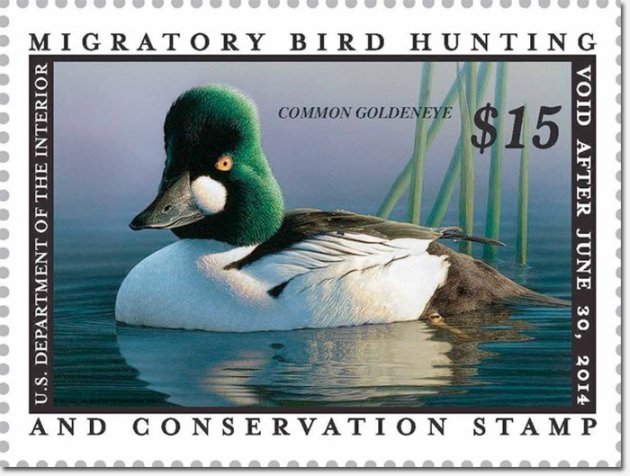
Issue 4: Access to many National Wildlife Refuges is restricted or extremely limited for waterfowl hunting and wildlife viewing even when lands are acquired by MBCF dollars
a) Recommendation: Improve the identification and reporting of Refuge areas open/closed to waterfowl hunting and wildlife viewing and the reasons for not providing access.
b) Recommendation: USFWS should work with the NAWMP community to identify priority areas for habitat acquisition, and to develop lists of land parcels available from willing sellers for submission to the Director and approval by the MBCC such that the limited MBCF funds are employed in a manner that maximizes the contributions of the NAWMP goals of waterfowl populations, habitat, and human users.
c) Recommendation: USFWS should examine the potential to increase the number of refuges that allow the use of a Federal Duck Stamp to access the refuge, including voluntary payment or self-pay systems, for all recreational uses.
Issue 5: The increased price of the Federal Duck Stamp may affect sales of the federal stamp and state-level waterfowl hunting privileges or state conservation stamp sales
a) Recommendation: Assess impacts of increased price on federal Duck Stamp sales and state waterfowl stamps/licenses
b) Recommendation: AFWA should request data from individual states on waterfowl stamp/permit sales, participation in waterfowl hunting, etc., and compare it to federal stamp sales, revenue, and Harvest Information Program estimates.
1) Action: Select key states and compare sales of licenses and federal stamps before and after increase
2) Action: Determine correlation between HIP-derived hunter numbers and sales of state/federal stamps
Issue 6: The current uses of the Duck Stamp are limited to only those engaged in waterfowl hunting, or access to a very limited number of National Wildlife Refuges
a) Recommendation: Identify new (non-hunting/recreational) uses for the Duck Stamp.
1) Action: Cooperate with hunting, viewing, and tourism industry to provide a national discount to sporting good stores, national bird specialty stores, car rentals, etc.
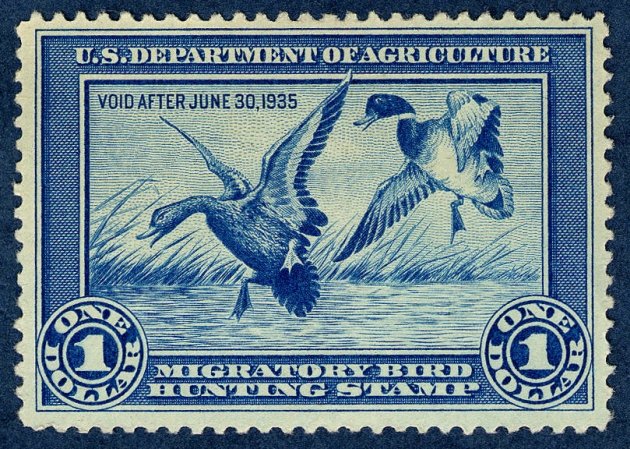
One of the distinguished members of the Task Force was Paul Baicich, founder of the Friends of the Migratory Bird/Duck Stamp, whose ideas from his January 2015 newsletter were actually incorporated into the Task Force Final Report. In the February 2015 issue of Paul’s Wingtips newsletter, the idea of adding an additional non-waterfowl bird to the Duck Stamp design was put forward. This is obviously where the FWS got the idea for their new proposed rule to alter the Duck Stamp Contest.
The new regulations were open to comments until March 22, 2016 and received 572 comments. This is part of the comment left by Paul:
This excellent proposal by the Service is a real opportunity to:
1) draw positive attention to the centennial of the Migratory Bird Treaty,
2) provide new artistic challenges to the participating bird artists in the Duck Stamp Art Contest (and potentially bring in new artists),
3) generate additional enthusiasm among people to support migratory bird conservation (increase people’s understanding that it’s “not just for ducks,”) which may motivate more Americans to buy the Stamp.The USFWS program for the Migratory Bird Hunting and Conservation [Duck] Stamp combines great art and design with a proven record of solid conservation that goes back over 80 years, securing vital wetland and grassland habitat for the National Wildlife Refuge System and providing important recreational opportunities for all Americans. It’s art and conservation, both simple and beautiful.
With the recent increase in the price of the stamp – to $25 – it is important to devise innovative ways to make the Stamp more appealing, especially for those Americans who are not required to buy a Stamp. It is crucial to find out how to sell more Stamps for conservation. Modifying the art rules to include additional and appropriate bird species is an ideal way to raise that possibility.
Even though funding for the National Wildlife Refuge System is in serious trouble, forcing wildlife artists to add another bird species to their Duck Stamp hoping it is going to create additional interest and income for the refuge system seems rather far fetched.
After much research and consideration given to this subject I have reached the conclusion that the only two groups of people that give a hoot about what the actual Duck Stamp looks like are the stamp artists and the philatelists. The waterfowl hunters don’t really care because they have to purchase a stamp no matter what. Other wildlife enthusiasts that want to contribute to wildlife conservation don’t care if a non-game bird is depicted on the Duck Stamp either. We just don’t really want to be associated with hunting sport. We want our own conservation stamp!
After reading several of the comments it is obvious that the vast majority of people want the Duck Stamp to remain the same. Many commenters suggested that an additional non-consumptive wildlife conservation stamp should be implemented to attract more birders and wildlife watchers:
I am strongly opposed to the proposed rule change that requires artists to add a non-waterfowl migratory bird to the duck stamp. I have hunted waterfowl for over 50 years and have bought a federal duck stamp for nearly as many. I am also an avid wildlife conservationist who enjoys all birds, game and non-game alike. I purchase several duck stamps each year as I know they benefit the conservation of a range of wildlife, including non-waterfowl birds. The proposed rule change is a bad idea for a number of reasons:
1. The focus of the stamp should remain on waterfowl and not be re-focused or diluted by adding non-waterfowl species. The stamp has been hugely successful in providing funding to conserve wetlands by focusing on waterfowl. Please maintain the waterfowl focus as originally envisioned and intended by the first duck stamp artist and legendary conservationist Ding Darling.
2. If the presumed intent is to increase stamp sales to non-hunters to benefit non-waterfowl migratory birds than the intent is fundamentally flawed. The message that duck stamps benefit many non-waterfowl birds and other wildlife has been conveyed for many decades and yet the vast majority of duck stamp sales are still to hunters.
3. Requiring artists to include another bird species will complicate and compromise their ability to accurately and artistically depict the primary waterfowl subject given the compressed format required for the stamp.
There are other reasons not to change the stamp, but suffice to say my comments adequately frame my opposition to the proposed rule. If the intent is to increase funding for non-waterfowl migratory birds, then the Service should actively and aggressively pursue enactment of a non-waterfowl migratory bird conservation stamp. Leave the duck stamp alone! Sometimes the easiest path is not the right one.
Another comment from George Lang:
I am against this proposed change and definitely am not in favor of adding a second species to the Federal Duck Stamp. I would be in favor of a second separate Federal stamp for “birders”.
and John Kohler:
I am not in favor of this change …Lets have two stamps and have each group challenge the other for total purchases which would help all birds and promote birding for everyone.
and my favorite from Carrie McLaughlin:
As a Texas Master Naturalist and Audubon Master Birder, and a supporter of hunting, fishing, and the duck stamp, I think it would be a serious mistake to disturb this profitable tradition. Instead, we need to look very seriously at a perfectly acceptable and common sense alternate outlet for wildlife lovers who are not hunters or fishermen. Please see this link for a succinct explanation that does better than I can at articulating this position: http://thebirdersreport.com/wildlife-conservation-stamp.
A program like the wildlife conservation stamp would take off like a house afire, and would be wildly successful from the get-go. I can tell you right now that the many, many uninformed folks who are opposed to hunting and fishing will buy this alternative stamp in a heartbeat out of pure zealotry and a long pent-up need to beat sportsmen at their own game and “win for wildlife”. And THAT will then immediately and necessarily up the ante from the duck stamp folks, too. 🙂 Some healthy competition with the dollars to see who has the most influence is nothing but a win for the refuge system, too.
Richard Coniff just wrote this article on the same subject https://strangebehaviors.wordpress.com/2016/03/18/how-the-hook-and-bullet-mindset-still-rules-our-wildlife-agencies/, and it’s fast and furiously making the rounds at TPWD. It would behoove you all to pay close attention. Nix the changes in the duck stamp. Create and promote the wildlife conservation stamp. Double your profits. Strengthen the refuge system. Win, win, win…


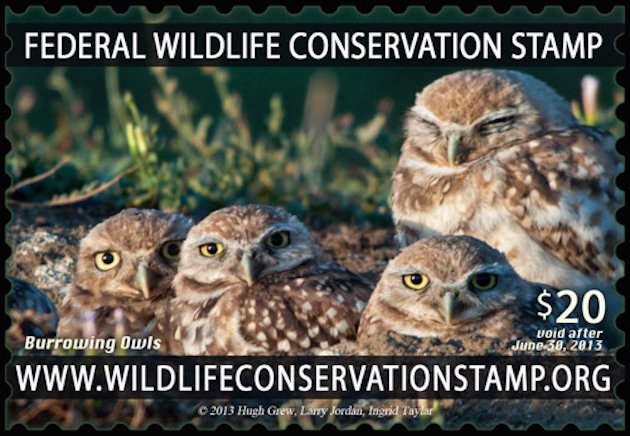











Never change a running system. Two stamps would make more sense.